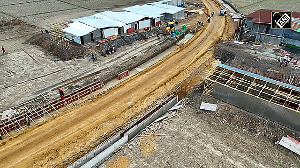 Equations have changed in the new India. If the ’60 and the ’70s saw migration of people from South India to North India, it is the reverse right now. And without understanding this new dynamics, if the ruling party were to impose on the majority a language spoken by just 45 pc of the people, it is unlikely to be accepted without demur, says Shobha Warrier. Illustration: Uttam Ghosh/Rediff.com
Equations have changed in the new India. If the ’60 and the ’70s saw migration of people from South India to North India, it is the reverse right now. And without understanding this new dynamics, if the ruling party were to impose on the majority a language spoken by just 45 pc of the people, it is unlikely to be accepted without demur, says Shobha Warrier. Illustration: Uttam Ghosh/Rediff.com
I consider myself an Indian; a non-Hindi speaking one at that. As a school student, I had taken the national pledge everyday in the school assembly with my arms stretched out front, ‘India is my country. I love my country and I am proud of its rich and varied heritage. I shall strive to be worthy of it. I shall give my parents, teachers and all elders respect and treat everyone with courtesy....’
I studied in a government school in Kerala. But yet, somehow, we took the pledge in English, and not in Malayalam or Hindi.
Now, I wonder whether the members of the ruling party ever repeated this pledge in school. If they had said it everyday in school with utmost sincerity, they would have remembered that India has a 'rich and varied heritage' and they had to 'respect and treat everyone with courtesy'.
How else can anyone explain the circular by the home ministry’s department of official languages on May 27 asking all ministries, departments, public sector undertakings and banks to give prominence to Hindi while using their respective accounts in social media? ‘The instructions of the department of official languages has only reiterated the Government of India’s existing policy on the use of Hindi, whereby the use of Hindi is compulsory only in the central government’s communication with the Hindi-speaking states,’ the circular said.
I was reminded of the anti-Hindi agitation spearheaded by the Dravida Munnetra Kazhagam and M Karunanidhi in the ’60a. If it weren’t for the DMK and him, Hindi would have become the first language in all the schools. If not for Tamil Nadu, all of the other languages of India would have been drowned in a deluge of Hindi.
Although I learnt to read and write Hindi quite well in school, and though I have nothing against Hindi as a language, I felt eternally grateful to the Dravidian parties and Karunanidhi. It was only because of this agitation that Nehru had to assure the non-Hindi speaking Indians that English would remain the official language for as long as the non-Hindi speaking populace wanted it. English continues to be an official language, as non-Hindi speaking Indians preferred English to Hindi.
In 2014, the Bharatiya Janata Party-led ruling coalition has reinforced the belief many in south India have, that it is a party dominated by the Hindi-speaking people from the northern belt, who cannot look beyond their own culture and language, and who cannot understand the multifariousness of a country like India.
If they were enamoured by the lakhs and lakhs people assembling to listen to Narendra Modi speak in Hindi in Chennai, Madurai and Thiruvananthapuram, it was not because the people of these areas loved or understood Hindi. The situation in the country was such that the people saw hope, optimism and confidence in the man.
The way the people of south India protested to the circular, it was quite evident that it was one thing to talk about Pavitra Mandir, Achche Din, etc, but if the party's intentions went beyond that, they would not take it lying down; they would not let others trample upon them.
It was without realising how the country has changed in the last couple of decades that the ruling party tried to impose Hindi on non-Hindi speaking Indians once again.
The ’60s and the ’70s was the period when people from the southern part of India moved to cities like Delhi, Bombay, Jamshedpur, and Bhilai in search of employment. And people from Tamil Nadu found that not knowing Hindi was a major handicap for them -- but then, people do learn fast to survive. They survived, and did quite well in the northern and western part of India as 'Madrasis.'
It was in the ’80s that I went to stay in the western part for a couple of years. I was shocked and alarmed when people addressed me as a Madrasi and the language I spoke as 'Malyali'.
How India has changed now! Today, the streets of Tirupur, a small textile town in Tamil Nadu are full of semi-literate people from Uttar Pradesh, Bihar and Jharkhand, and to my amazement, I found them communicating in Tamil to shopkeepers. To them, south Indians are not Madrasis anymore. They also know the language spoken is Tamil and not Madrasi!
In Chennai, I saw Hindi-speaking workers from UP, Bihar, etc asking for oru kilo rice, nooru gram parippu and oru packet paalu. The other day, a shopkeeper asked me to teach him 1-20 in Hindi. 'When you have so many customers who only know Hindi properly, I have to learn Hindi,' he said with a smile to me. There is no emotion involved here but pure business sense!
Similarly, you see people from West Bengal, Odisha and the North East flocking to Kerala for work. If I were to say theatres in a small town like Perumbavur run morning shows in Bengali and Odiya films on Sundays, you will realise the kind of influence the migrant labourers have in the area. All these people have picked up enough Malayalam to live in the state. This is how people learn to co-exist.
Equations have changed in the new India. If the ’60 and the ’70s saw migration of people from South India to North India, it is the reverse right now.
The CEO of India's leading temporary staffing company with more than 500 locations in India said in an interview with Rediff.com that in the next 25 years, 45 per cent of India’s GDP growth and just five pc of the population growth would come from the south and west of India, while 45 pc of the population growth and five pc of the GDP growth would come from the Hindi heartlands of Uttar Pradesh, Bihar, and Madhya Pradesh.
He added, “It is interesting to see whether we are going to see massive migration or whether we will create jobs there. Our training institute has a large presence in the north and the east, but the recruiting and client base are in the south and west of India. It will stay this way: supply from the north and east and demand for labour will be in the south and west.”
Whether one likes it or not, there are two Indias now; one that produces employment and the other that generates labour. That is the reason why we see reverse migration happening now; from the north to the south for employment. Now the question is, who has to learn whose language?
Without understanding the new dynamics, if the ruling party were to impose on the majority a language spoken by just 45 pc of the people, it is unlikely to be accepted without demur. And the ensuing storm of protest was why they had to come out with the explanation within a few days that, ‘this is neither a new policy nor an attempt to impose the use of Hindi on any non-Hindi speaking state’.
Karunanidhi was, once again, the first person to raise his voice against the bigoted and insular voices in the ruling party. I am glad he is still around at 90 to fight for the 55 pc of Indians for who Hindi is not their first language.











